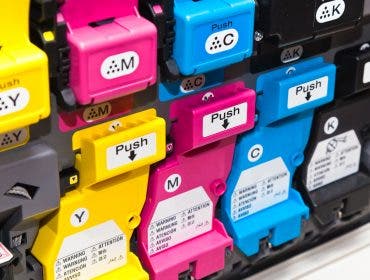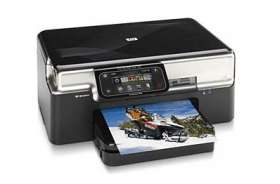Whether you make them at home or have them done by a lab, prints are the best way to preserve your important images.
|
Home printing is easy and convenient, especially when working with a small number of pictures. And while Dye-Sublimation prints deliver photo quality prints, they are relatively expensive. Inkjet printers put an affordable digital darkroom on your desktop. Even better: If you want to make a quick print from your Smart Phone or iPad, many modern printers now have Wi-Fi or Bluetooth connectivity. Inkjet Printers: Positives and negatives Positives
Negatives
How inkjet printers work Inkjet printers form an image by spraying minuscule droplets of ink in extremely precise patterns. They heat ink that is confined in a tiny cavity to extremely high temperatures until it boils and literally explodes, blasting itself through a small opening as a microscopically thin stream. The volume of ink is measured in picoliters, and naturally, the smaller the volume, the tinier the ink droplet. A picoliter is one-trillionth of a liter. Another way to say it is one-millionth of one-millionth of a liter. However you say it, it’s much smaller than most people can even imagine. Dot’s nice These tiny droplets of ink are deposited on the paper as a series of dots. The best image quality is achieved when a very large number of very tiny dots are put down. The density can be measured in terms of dpi or “dots per inch.” More dots mean better images. A high dpi rating means that the ink is arranged in a very dense pattern and the image will be closer to what is known as “continuous tone.” Remember when, as a kid, you looked at a comic book with a magnifying glass? Remember all those dots? That’s what we’re talking about here, except instead of the 150 dpi you saw in the funny papers, you can produce 9600 dpi with a modern, sophisticated photo-quality inkjet printer. Inks: Four, six, or more?Photo quality inkjet printers by-and-large use six-color inks. General-purpose inkjets use four-color. A few high-end models use seven or eight colors. The more inks used, the wider the range of colors that the printer is capable of reproducing. A six-, seven- or eight-color printer will produce prints with a range of rich, finely-detailed color.
What about black-and-white? If you plan to make black-and-white prints, look for a printer that has more than one level of black ink. Some manufacturers have introduced inksets that are all grays and blacks. The idea is, like color, that the more different variations of grey ink in the printer, the richer the tonal reproduction in a black-and-white print. Of course, if you want a sepia-toned look, you’re better off using standard color inksets and setting the tone in your image-editing program. Size matters Printers are categorized by the size of the paper they can handle. For postcard-size snapshots, some 4×6-inch printers do an outstanding job. Their drawback is that they cannot print larger sizes, so they’re useless when it comes to printing a memo, address label or other miscellaneous, non-photo projects. Regular inkjet printers handle paper up to 8.5×11 inches (copy paper size) or larger. Some printers used by photo enthusiasts and professionals will print on paper sizes 13-inches wide or even wider. Large-format printers will print on poster-sized paper, 42 inches or even wider. Fine-art photographers have been experimenting with this format, but be aware that ink cartridges can get quite pricey when making poster-sized prints. Paper length, of course, is essentially unlimited. Speed: Yours may vary A printer’s speed is expressed in terms of ppm or “pages per minute.” That specification is self-explanatory, but in real life you may never achieve those theoretical numbers. Manufacturers follow rigorous test procedures that may or may not be under the same conditions you use. Connectivity: B.Y.O. Wires Most inkjet printers connect via USB (either standard or high-speed) and require that model-specific drivers be installed on your PC to control printer functions. The drivers, sometimes called Printer Utility Software, assure that the printer is set correctly for image type, paper size and surface, and other variables, and also display an ink monitor to help you keep track of how much ink is left. Don’t expect to see an interface cable in the box with the printer. Some manufacturers do, but most do not include this necessary accessory. Check, and plan accordingly. Also, find outwhat other software is included. A growing number of printers will work via your Wireless Wi-Fi router; it is relatively easy to set all Wi-Fi capable devices to choose the same printer so you can make prints without being wired in. PictBridge: No computer needed With a PictBridge-enabled printer, you simply plug your camera into a port in the printer, and make prints. Simple! Not all printers have this feature. So, if you have a PictBridge-enabled camera, look for the feature in the printer specs before you buy. |
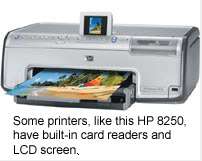
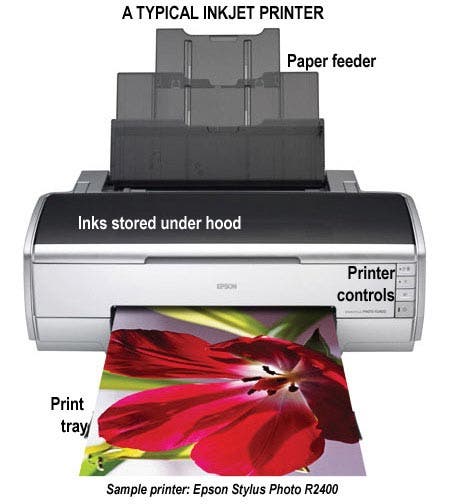
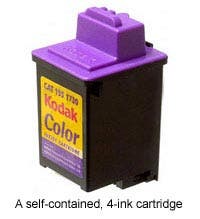 Output resolution ranges from 1200 dpi to 9600, but for most photo purposes, something in the 4800×1200 range is ideal. High numbers are good but for most practical purposes the laws of diminishing returns will take over sooner than you might think.
Output resolution ranges from 1200 dpi to 9600, but for most photo purposes, something in the 4800×1200 range is ideal. High numbers are good but for most practical purposes the laws of diminishing returns will take over sooner than you might think.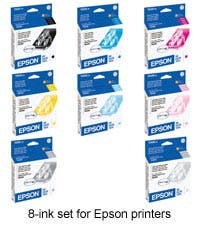 Depending on the printer, ink may be available in individual wells, or as a set. With separate cartridges it’s possible to renew one color without wasting the unused portion of the others. The disadvantage is the price shock when purchasing six new cartridges at the same time. When the color comes as a set, the black ink cartridge is usually separate–which is good if you use your color inkjet for other household printing chores like memos and letters.
Depending on the printer, ink may be available in individual wells, or as a set. With separate cartridges it’s possible to renew one color without wasting the unused portion of the others. The disadvantage is the price shock when purchasing six new cartridges at the same time. When the color comes as a set, the black ink cartridge is usually separate–which is good if you use your color inkjet for other household printing chores like memos and letters.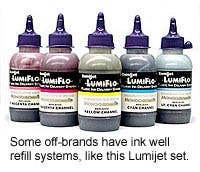 One more thing about inks: Many printer makers strongly discourage users from using any other brand inkset, and some go as far as to say that using off-brand inks will void the warranty. And with good reason: when a well-known photo magazine recently attempted to use an off-brand inkset in a well-known-brand printer, the ink gunked up the works, and ruined several machines before the test was finally cancelled. But that was an exception. There are third-party inks that will work fine in the printers they’re designed for, but before you buy, get on user forums and look for recommendations. Do your homework. If you use the manufacturer’s ink, you might not get much variety but the risk is much lower.
One more thing about inks: Many printer makers strongly discourage users from using any other brand inkset, and some go as far as to say that using off-brand inks will void the warranty. And with good reason: when a well-known photo magazine recently attempted to use an off-brand inkset in a well-known-brand printer, the ink gunked up the works, and ruined several machines before the test was finally cancelled. But that was an exception. There are third-party inks that will work fine in the printers they’re designed for, but before you buy, get on user forums and look for recommendations. Do your homework. If you use the manufacturer’s ink, you might not get much variety but the risk is much lower.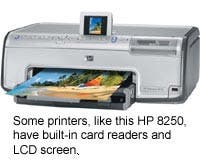 PictBridge is one of the latest features found in inkjet printers. The CIPA (Camera & Imaging Products Association) organization in Japan, a consortium of all of the major manufacturers, has created a standardized way for cameras to communicate with printers without having a computer connected in between. The PictBridge print communications protocol (alternatively known as “CIPA DC-001”) allows any PictBridge compatible printer to work with any PictBridge compatible camera, regardless of manufacturer. Along with USB, it’s one of the few true standards.
PictBridge is one of the latest features found in inkjet printers. The CIPA (Camera & Imaging Products Association) organization in Japan, a consortium of all of the major manufacturers, has created a standardized way for cameras to communicate with printers without having a computer connected in between. The PictBridge print communications protocol (alternatively known as “CIPA DC-001”) allows any PictBridge compatible printer to work with any PictBridge compatible camera, regardless of manufacturer. Along with USB, it’s one of the few true standards.